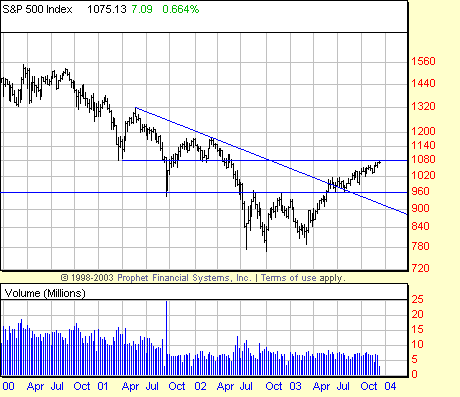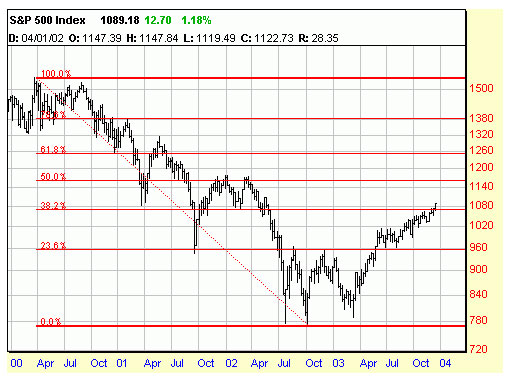

January 2004 A Xmas or New Year's Present to the readers. |
| Fewer Letters, but lots cheaper. Free. LINK TO JANUARY LETTERS |
| Our First Weekly letter will be posted week ending January 9 2004. |
| Meantime our first installment of the State of the Markets Letter (12/03--0104) has been posted. While we prepare those letters readers might enjoy the December Market Outlook from Prophet.net which is partially quoted here. If you are not a subscriber to Prophet we heartily recommend it. |
 Featured in this edition are year-end market opinions of three market technicians: Bruce Kamich (NOTE: Not included here), Charles Bassetti, and Tim Knight. All the charts shown were created with Prophet JavaCharts. You can use the full suite of features in JavaCharts by signing up for a free 7 day trial here: Prophet.Net: Premium Services https://www.prophet.net/forms/subscribe.jsp Attention TASC Readers! Want to help us? The voting is almost over for Technical Analysis of Stocks and Commodities (TASC) magazine's annual Readers' Choice Awards. Prophet.net is on the ballot in two categories, Subscription Internet Analytical Platforms and Technical Analysis Websites. Voting ends December 31, 2003. If you subscribe to TASC and enjoy working with Prophet.net, we would appreciate your vote! TASC subscribers can vote online at http://technical.traders.com/Products/ballot.asp. Thank you! Market Opinion by Charles Bassetti, Editor of the Edwards and Magee classic Technical Analysis of Stock Trends, 8th Edition We know personally (and the 12/14/03 NY Times documents) some reputable and competent managers who are out of the market altogether. Their clients are now going crazy after a nine-month bull market (or bear market rally, depending on your point of view). Since April John Magee Technical Analysis::Delphic OR (edwards-magee.com) has been long the Dow. This is a speculative position for the mid-to-long term spec and investor. Our friends on the sidelines are right, because a monster bear market is coming. In the meantime make hay while the sun is in Jupiter, or something like that. Some prominent analysts (P&F variety) are looking for 11,400 in the Dow. Some of our original analyses projected a minimum target of 10,400 in the Dow. For the moment we are long and are urgently recommending that shorts be found to create a natural hedge. One airliner shot down with a shoulder-fired missile could start the avalanche. Barring the unforeseen, we will exit when the trend changes, as we do not believe in target trading, by and large. Note that a 31-month trendline is broken after the formation of a (more or less) 15-month base. Although this rally (bull market?) is based on smoke and mirrors and neo-con cons, the profits are real.  The S&P similarly shows the break of a long term trendline, but is weaker than the Dow, being smack up against some heavy-duty resistance. Nonetheless, long is still the way to be. Look at the last nine months here and picture a rounding top.  We got long the Qs in April, the first of the indices to tempt us out of the bearish and neutral posture we have been in since late 1999. Once again, the suggestion of a rounding top is here, and, lately, the NASDAQ has begun to diverge from the Dow. Whether this is just a lag or a divergence is not clear yet. But it is difficult for us to think the party is over yet. The timing is wrong for the presidential election. The party in power (the borrow and spend Republicans) have to keep pumping until November of next year, so it's hard to see a total wipeout until after the November election. Given the liquidity flooding the system and the Fed's docile acquiescence and no terrorists running planes into the Capitol, this market might just round on over and give us the chance to book some good profits on the long side and give us plenty of time to get short. We are thinking daily about Richard Russell's remark that the Dow and the price of Gold will cross in midstream.  Market Opinion by Tim Knight, Founder and President, Prophet Financial Systems Although my own trading this year has been both long and short, I am decidedly bearish for 2004. Quite possibly, we could be in a secular bear market until approximately 2013. There will obviously be rallies in the midst of this decline (such as the substantial rally we've seen for most of this year), but by and large it could be ugly (unless you're short). First, let's take the very long view. Here is the Dow Jones Industrial Average for about the last 100 years (yes, Prophet really does have that much data stored). The popular sentiment is that the bear market (from March 2000 until October 2002) "deflated" the market to a point where it represents good value. As you can see from this graph, this isn't quite the case. The enormous ascent from 1982 until 2000 is still almost completely intact, which represents a lot of "air" through which the market could plummet. More likely, in my mind, is a market similar to the one shown from 1966 to 1982: a meandering descent which, particularly if you take the inflation of the 70's into account, was a brutal 16 year decline in equity values. Relatively speaking, we could be in the same place now as the market was at in 1969 (that is, the first retracement up preceding another more severe commencement downward).  Let's now zoom in to a tighter timeframe: about the past 4 years, which captures the entire bear market earlier this decade. The graph below shows the S&P 500 index, overlaid with Fibonacci retracement lines (Fibonacci studies are available to Gold members at Prophet.net). The retracement is drawn from the top of the market in March 2000 to the bottom in October 2002. The index has bounced off the retracement levels fairly regularly. The very recent uptick in the market has pushed it past the 38.2% level. This does not necessarily mean an unbridled ascent to the 50%, although since it's cleared 38.2%, it's entirely possible.  Another element in this chart is a crude but still usable inverted head and shoulders pattern spanning from June 2002 to May 2003; a target price of 1,144 can be inferred using traditional measurement techniques, which would put the index within reach of 50% but still not besting the values set back in March 2002. Therefore, should the market resume descending at that point, the "lower highs" typical in a bear market would still be the case (e.g. no clear trend reversal). Lastly, let us turn our attention to a percentage comparison between the Dow Jones Industrial Index (which is typically seen as a relatively stodgy "blue chip" index) and the NASDAQ 100 (which is conversely seen as the most volatile and high-flying technology-based index). The 60-day intraday graph below shows the phenomenon which is just starting to attract some attention: that the Dow is actually substantially outpacing the NDX. What you see in October and November is more typical: the movements of the NDX are typically substantially higher than the Dow. But the NDX seems to have lost steam, whereas the Dow has spent the past month doing little but climbing higher. This is precisely the opposite "decoupling" seen just before the bubble burst in March of 2000; during the first portion of 2000, the Dow languished while the NDX exploded ever higher.  So when is the market going to resume an earnest and unrelenting path down? Obviously an unpredictable news event could shatter the market, but by definition there is no way to predict that. What the charts tell me, however, is that even if this uptrend in the market has a few months of steam left in it, it will eventually run out, and it's more than likely that the lows set even in October 2002 could be snapped. For those of you not inclined to shorting stocks or buying put options, I would add a couple of other remarks. First, this bearish prediction could certainly be set aside if the uptrend we've seen since October 2002 remains in place and the rounding top we're seeing in the Nasdaq is exceeded by higher price levels. And even if we do have a 1966-1982 style market on our hands, I would point out that Peter Lynch, still regarded as one of the best stock pickers ever, made his name during the 1970s - - even in the worst bear market, outstanding companies still appear, and prudent stock selection can still yield excellent rewards on the long side. Forgot Your Password? To have your user name and password sent to you via email, follow this link: http://www.Prophet.Net/help/#forgotpass If you wish to be removed from future announcements, send a blank email to remove@Prophet.Net DISCLAIMER: Please note that the above opinions are just that - opinions - and do not constitute investment advice. Prophet offers the viewpoints of these authors for your reading and further analysis, but Prophet in no way endorses these opinions for any use, particularly for use as investment guidance. |
| About jmta::dor | Contents | Courses | Buy MTP/SOM | Books | Subscribe | TAST8 | Home |